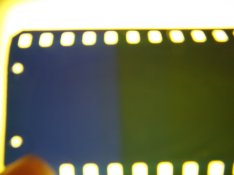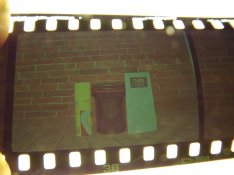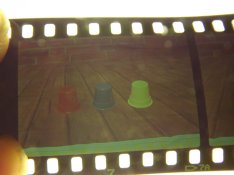Hello,
I was doing some experiments recently, with expired Fuji Velvia 100 (expired in 2007).
-
So here is the method I used.
I shot the film in iso 50,
and I developed it in rodinal (made by me) in 100:1 for one hour and I dont use fixer.
After 1 hour (remember skipping fixing)
I take the film out from the tank, let the film sit under light so film can fog.
I'm not experienced in E6 whatsoever but I think in E6 you use a chemical to fog the film. Am I right on that?
--
Alright, after about 30 minutes or so (doesnt really matter I guess)
I put the film back to the reel and develop it with c41 chemicals (which are made by me as well)
my formula is two step c41 developer, like diafine you dont mix A with B.
---
After developing it I bleach the film, and than fix it.
My results arent professionally usable but better than Cross I believe.
My question is, Im not that experienced in darkroom to be honest and positives I'm getting too white (yes, I'm getting positives). Example will be given.
I can scan my negatives, do some photshop stuff and get somewhat lomography looking e6-ish images.
I need suggestions for developing times because what I feel like is if my positives come out 1 or 2 stops lower they will be good use!
Shot using Hasselblad 500C + 80mm 2.8 CT
Fuji Velvia 100 (expired 2007)
Scanned with Canon 8600F
Results:
one: https://www.flickr.com/photos/k2adir/25391439121/
Two: https://www.flickr.com/photos/k2adir/25458148466/
-
here is photo of the positive: https://www.instagram.com/p/BCenZW9NMrR/?taken-by=k2adir
video of the positive/negative right after BW dev: https://www.instagram.com/p/BCeHFa-NMpG/?taken-by=k2adir
---
I'm a collage student and I cannot throw away that much of film for my experiments that is why I'm asking help (or you may donate some film to this broke kid ). Please give me suggestions for dev times, do you experiments and share with me. I mean do all that stuff. E6 chems are getting expensive, cross sucks. It wont be professional enough, yeah I got that but it will be usuable for daily shootings and hobbies, etc.
). Please give me suggestions for dev times, do you experiments and share with me. I mean do all that stuff. E6 chems are getting expensive, cross sucks. It wont be professional enough, yeah I got that but it will be usuable for daily shootings and hobbies, etc.
Temp I use was room temp, about 20-23Celcius. My C41 dev doesnt care for temp to be honest. It gives about the same results from 18-25C
thanks!
I was doing some experiments recently, with expired Fuji Velvia 100 (expired in 2007).
-
So here is the method I used.
I shot the film in iso 50,
and I developed it in rodinal (made by me) in 100:1 for one hour and I dont use fixer.
After 1 hour (remember skipping fixing)
I take the film out from the tank, let the film sit under light so film can fog.
I'm not experienced in E6 whatsoever but I think in E6 you use a chemical to fog the film. Am I right on that?
--
Alright, after about 30 minutes or so (doesnt really matter I guess)
I put the film back to the reel and develop it with c41 chemicals (which are made by me as well)
my formula is two step c41 developer, like diafine you dont mix A with B.
---
After developing it I bleach the film, and than fix it.
My results arent professionally usable but better than Cross I believe.
My question is, Im not that experienced in darkroom to be honest and positives I'm getting too white (yes, I'm getting positives). Example will be given.
I can scan my negatives, do some photshop stuff and get somewhat lomography looking e6-ish images.
I need suggestions for developing times because what I feel like is if my positives come out 1 or 2 stops lower they will be good use!
Shot using Hasselblad 500C + 80mm 2.8 CT
Fuji Velvia 100 (expired 2007)
Scanned with Canon 8600F
Results:
one: https://www.flickr.com/photos/k2adir/25391439121/
Two: https://www.flickr.com/photos/k2adir/25458148466/
-
here is photo of the positive: https://www.instagram.com/p/BCenZW9NMrR/?taken-by=k2adir
video of the positive/negative right after BW dev: https://www.instagram.com/p/BCeHFa-NMpG/?taken-by=k2adir
---
I'm a collage student and I cannot throw away that much of film for my experiments that is why I'm asking help (or you may donate some film to this broke kid
 ). Please give me suggestions for dev times, do you experiments and share with me. I mean do all that stuff. E6 chems are getting expensive, cross sucks. It wont be professional enough, yeah I got that but it will be usuable for daily shootings and hobbies, etc.
). Please give me suggestions for dev times, do you experiments and share with me. I mean do all that stuff. E6 chems are getting expensive, cross sucks. It wont be professional enough, yeah I got that but it will be usuable for daily shootings and hobbies, etc.Temp I use was room temp, about 20-23Celcius. My C41 dev doesnt care for temp to be honest. It gives about the same results from 18-25C
thanks!
Last edited:






 . I have another body coming from Ebay. I have limited slide film so have to shoot 8 frames, open camera in dark and cut off the frames for development. ( Boots the Chemist film is the worst of the slide films I have used for this process, so I try to stick to it) My last try was using a positive B&W developer for 1st dev, then fog and another soak far half the time in a weaker B&W pos dev before the colour dev in C41. The result was OK, the film came out translucent, but the images are very faint. Also I'm not sure of the C41 I used it is a few months old. When I get a new camera I will redo the test with fresh chemicals. I do not have a film scanner so it is difficult for me to properly show you the results.
. I have another body coming from Ebay. I have limited slide film so have to shoot 8 frames, open camera in dark and cut off the frames for development. ( Boots the Chemist film is the worst of the slide films I have used for this process, so I try to stick to it) My last try was using a positive B&W developer for 1st dev, then fog and another soak far half the time in a weaker B&W pos dev before the colour dev in C41. The result was OK, the film came out translucent, but the images are very faint. Also I'm not sure of the C41 I used it is a few months old. When I get a new camera I will redo the test with fresh chemicals. I do not have a film scanner so it is difficult for me to properly show you the results.